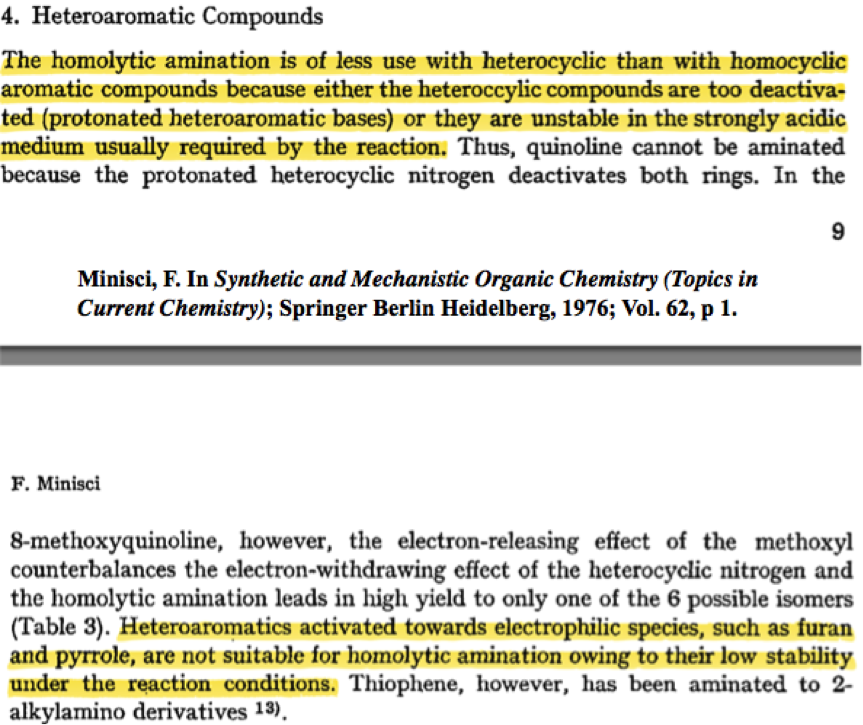Aromatic C–H amination has received a lot of
attention over the last few years, and our efforts began late 2012. The goal
was simple: create a nitrogen-centered radical and trap it with a heterocycle.
Instead of talking about our journey towards this
reagent, I personally think the succinimidyl radical (S·)
deserves a little bit more attention. Succinimidyl radicals are an elusive
species, and for the longest time have been thought to exist in the Π
electronic configuration due to the observation of species 1 in the Wohl–Ziegler bromination reaction. Two mechanisms
supporting different radical chain carriers have been reported. While the
Goldfinger mechanism (Br2 is the main radical chain carrier) has
been widely accepted, it was later proven that Bloomfield’s mechanism where S· is
the chain carrier would become the dominant pathway when either a different solvent
or with substrates bearing less reactive hydrogens were used. Attempts to trap
the S· were successful, and this radical is now proposed
to exist in the ∑ configuration as well. This suggests that the S· is a
very reactive but unselective species. Skell and coworkers successfully showed
that C–H imidation of olefins or aromatic systems was possible with NBS by
using an excess of sacrificial olefin (to trap the Br2) (see Chow et al., Can. J. Chem. 1979, 57, 1967; Skell et al., J. Am. Chem. Soc. 1978, 100, 1950).
Apart from the inability to characterize the S·, the
unsually strong N–H bond strength (~110 kcalmol-1) of succinimide
seems to suggest that this radical would undergo spontaneous H-abstraction. For
the longest time, we were surprised that the S· would give us any
product at all, instead of undergoing rapid H-abstraction. A report by Skell
then shed some light on this intriguing species. This study uses glutarimidyl
radical (G·) instead, as they are known to be more stable
and do not undergo ring opening. Interestingly, H-abstraction selectivity of
the G· did not parallel that of relative C–H bond
strengths. In the study of halogenation of neo-pentane and dichloromethane, it
was found that neo-pentane reacted more rapidly, even though the C–H bond was
stronger. This ‘disregard’ for bond
strengths is also observed with Cl· and S·, which
can be rationalized by an early transition state where the product stability is
not a major significant factor. This is in stark contrast with a Br· where the ratio of hydrogen abstraction
(neo-pentane/CH2Cl2) = 0.06, reflecting the effect of
relative bond energies in a later transition state (see Lind et al., J. Phys.Chem. 1993, 97, 1610; Skell et al., J. Org. Chem. 1986, 51, 2071).
Having a greater appreciation for the S·, we
are excited that this radical was able to add to a variety of different
(hetero)aromatic systems.
 Lastly,
we would like to thank our Bristol-Myers Squibb collaborators, in particular
Dr. Martin D. Eastgate (left) for his incredible insight and valuable
suggestions. Over the past year and a half, Martin has been communicating with
us on a biweekly basis via teleconference regarding this project. As a graduate
student in an academic environment, this was initially pretty stressful due to
the need for periodic updates. However, it soon transformed into an
exhilarating experience because it was as if I had two ‘bosses’, and their
enthusiasm and drive definitely rubbed off on me. Martin’s undying optimism was
an incredible asset, and we are happy to have him work with us on this very
exciting project.
Lastly,
we would like to thank our Bristol-Myers Squibb collaborators, in particular
Dr. Martin D. Eastgate (left) for his incredible insight and valuable
suggestions. Over the past year and a half, Martin has been communicating with
us on a biweekly basis via teleconference regarding this project. As a graduate
student in an academic environment, this was initially pretty stressful due to
the need for periodic updates. However, it soon transformed into an
exhilarating experience because it was as if I had two ‘bosses’, and their
enthusiasm and drive definitely rubbed off on me. Martin’s undying optimism was
an incredible asset, and we are happy to have him work with us on this very
exciting project.
-Klement






Hi, I really enjoyed this piece of work! No direct questions at the moment, but I wanted to point out a minor error. I believe the references in Figure 1 A (selected examples of innate) are mixed up. Based on the text, 2h should be 2k, 2j should be 2m and 2k should be 2n. Only noticed as I am doing a lit. presentation on your work. You probably just made the figure, then changed your references later. Cheers!
ReplyDeletePlease have you looked into diacylperoxides, for the self-immolative reagent design, i.e. (SuccinimideOCMe2CO-O)2.....? In this way you would have homolysis into two symmetrical halves so perhaps the reaction system would produce the succinimidyl radicals more cleanly.
ReplyDelete